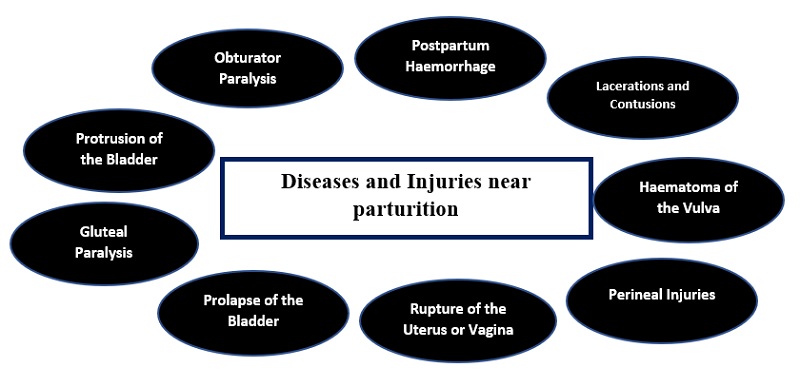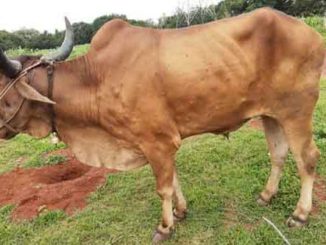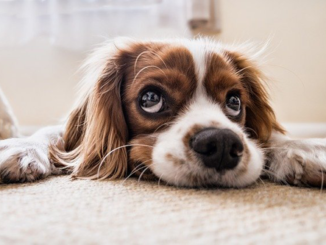Introduction
There are numerous problems that occur around parturition and thus affect the health of the dam very critically. A lot of problems like trauma of the genital tract or bony pelvis may lead to fatal haemorrhage or infection or to disability due to fractures, dislocations, or paralysis, displacement, herniation, rupture of the pelvic or abdominal organs. These problems lead to the economic losses when seen from the farmer perspective and animal welfare point. Although, in natural parturition, injuries may happen suddenly but it is a rare scenario. However, more common injuries are due to a delay in giving obstetrical care to dystocia cases, or bad and unsympathetic, unhygienic obstetrical practices, performed by unskilled workers or quacks. If we can provide good veterinary services at right time to animals with dystocia, we can prevent these injuries/ disease and subsequent losses will be markedly reduced. So, it is necessary to know about these problems for the field application.
Types: There are ample injuries and diseases near the parturition and given below in diagram:

- Postpartum Haemorrhage: In veterinary obstetrics, the serious haemorrhage can occur due to trauma of a uterine blood vessel by an unguided fetal appendage, the rough traction before the cervix has fully dilated, or via an obstetrical instrument e. g. hook, hand of the obstetrician e. g. large nails. After removal of the fetus, much blood may accumulate in the uterus before it begins to escape via the vagina; alternatively, blood may drain through a tear in the uterine wall into the abdomen. Keep in mind that while handling these types of cases, gently apply tractions, guide the hoof of calf with hand and apply ample of lubricants.
- Lacerations and Contusions: When applying excessive forces to the foetus, cervix and vulva most likely to be suffer with contusions and retroperitoneal fat make it more prone to rupture. This is further infected by Fusobacterium necrophorum and turn into necrotic vaginitis, which is immensely painful to the animals.
- Haematoma of the Vulva: It is a sequel to the contusion of the submucous tissue during delivery. One lip of the vulva is usually affected, and an obvious round swelling occupies the vulva orifice. The condition may arise spontaneously in the mare, but in both cows and mares it is likely to follow assisted delivery in which considerable manipulation or forced traction was required. Haematoma of the vulva may be confused with prolapse, tumour, or cyst of the vagina.
- Rupture of the Uterus or Vagina: Rupture of the uterus may occur spontaneously, but faulty obstetrical technique is a more frequent cause. Spontaneous rupture is most likely to arise in association with uterine torsion or with cervical non-dilation, but is also possibly due to the gross uterine distension that occurs with twins in one horn, with hydrallantois, or with excessive fetal size. The most likely time of spontaneous rupture is in late gestation or during labour.
- Protrusion of the Bladder: Protrusion of the bladder through a rupture in the wall of the vagina may occur during or after parturition. The rounded organ protrudes from the vulva. The kink that forms in the urethra prevents micturition; thus, the organ progressively distends with urine. The surface of the bladder is cleaned, and the organ is punctured with a hypodermic needle to allow drainage of urine. It is then dressed with an antibiotic powder and gently pushed back into place through the vaginal rupture. The latter is then repaired. Epidural anaesthesia will greatly facilitate return of the protruded organ.
- Prolapse of Perivaginal Fat: Prolapse of perivaginal fat is most likely in over-fat heifers of beef or dairy breeds and is a sequel to a rupture of the vagina, often a small one. The site of rupture is typically at the junction between the vagina and vestibule. The fat should be carefully removed with scissors or an emasculator, and if possible, the vaginal tear should be sutured.
- Gluteal Paralysis: Gluteal paralysis is seen in the mare and cow; in the mare it occurs after a spontaneous birth. It is recognised when the dam is found to have difficulty in rising and when she walks with ‘weakness of the hindlimbs’. Later, atrophy of the gluteal muscles is apparent. If the mare or cow cannot get up within a few days of parturition the prognosis is grave.
- Obturator Paralysis: Obturator paralysis is more frequent in cows than mares. Obturator paralysis occurs with the delivery of an oversized calf, causing compression of the nerve roots of L5 and L6 or compressing the obturator nerve as it courses down the medial shaft of the ilium. legs slide out laterally (in a characteristic ‘Froglike’ position on its ventral abdomen with the hindlimbs flexed but abducted. If the cow falls, there is a risk of limb fracture or dislocation of the hip joint.
Prevention of these injuries
- Ample amount of lubrication during obstetrical procedures: Use lubricant which are water based and should be able to float the fetus in the uterus for easy mobility.
- Gentle handling during parturition: Hands of obstetrician should have nails trimmed and should handle the fetus and uterus gently.
- Avoid excessive forces during traction: No excessive forces should be used i.e.; an ideal traction should be limited to four persons. However, in field condition, it is seen that people use tractors for pulling the fetus.
- Proper veterinarian should handle obstetrical cases: In field, unskilled person, quacks, and some farmers are also doing obstetrical malpractices and creating a havoc to the animals. It is farmer’s sole duty to get animal handling by a proper veterinary doctor to avoid such problems.
- Opting cesarean section in case of oversized fetus: It is the obstetrician’s decision if obstetrical handling or cesarian section is to be done. It is advisable if there is no visible change in the condition of the cases of dystocia twenty minutes within start of the handling, go for cesarian section to save the fetus as well as dam.
| The content of the articles are accurate and true to the best of the author’s knowledge. It is not meant to substitute for diagnosis, prognosis, treatment, prescription, or formal and individualized advice from a veterinary medical professional. Animals exhibiting signs and symptoms of distress should be seen by a veterinarian immediately. |







Be the first to comment